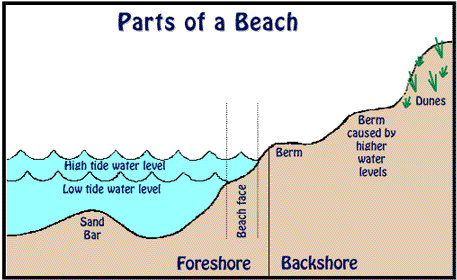| East Beach ~ Barrier Beach |
Physical Characteristics |
| East Beach ~ Barrier Beach |
Physical Characteristics |
What is a beach?The beach is the area of a shore that is made up of loose sediments, especially sand. A beach covers the area from the low water (tide) line to the dunes. A beach primarily has two parts. The backshore is the area of dry sediments that is only covered by water during the highest tides or most severe storms. The berm separates the backshore from the foreshore, or intertidal area. The area just below the low tide line is sometimes included as a part of the beach because this is the area where most of the sand moves.
What are berms?Berms form where the foreshore and backshore meet. Berms are formed when waves deposit sediments at high tides and they mark the highest point on the beach that waves reach. Berms are very easy to spot because they have a higher elevation and flat tops, like terraces. Sometimes more than one berm is formed on a beach. Severe storms cause berms to form closer to the dunes because the waves have more energy to reach a higher part of the beach. Usually berms are formed closer to the beach face where normal, gentler waves break and deposit sand and sediments. The berms formed by storms often remain undisturbed until another severe storm strikes whose waves can reach the upper beach.
What are some additional parts of the beach?The beach face is the area between the low and high water/tide levels. This area is also called the intertidal zone. The slope of a beach is determined by the size of the sediment particles and the amount of wave energy. Although not truly part of the beach, sand bars form just offshore and are an important supplier of sand and sediments to the beach.
